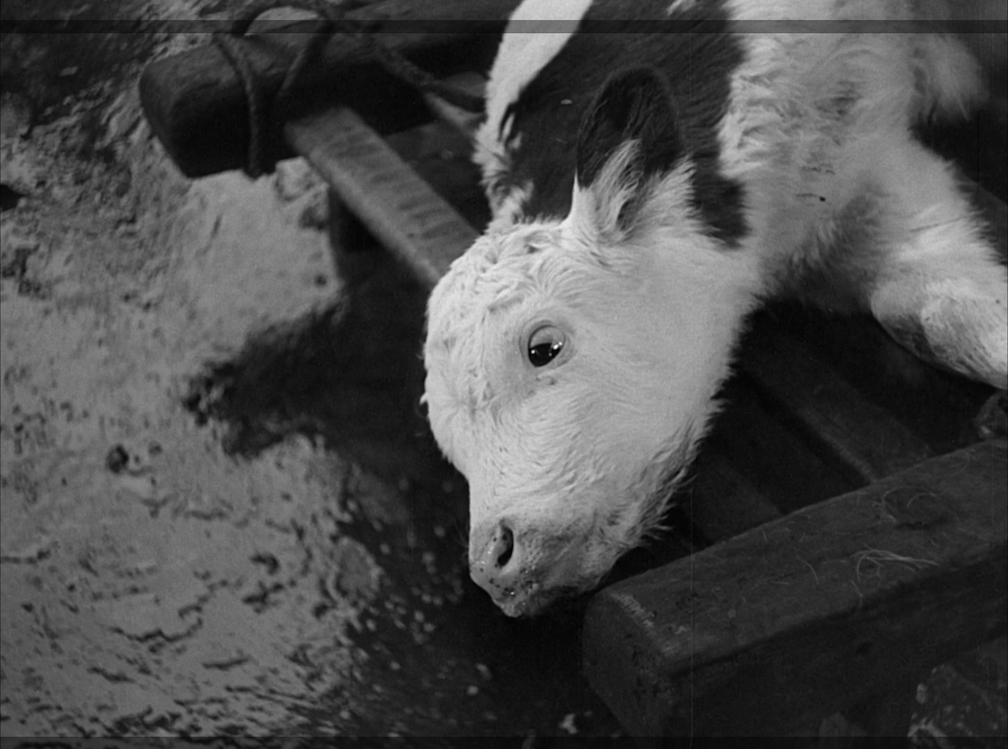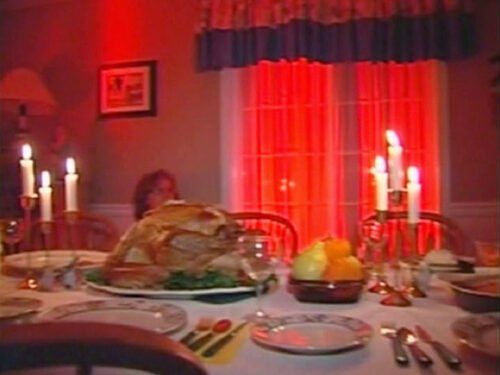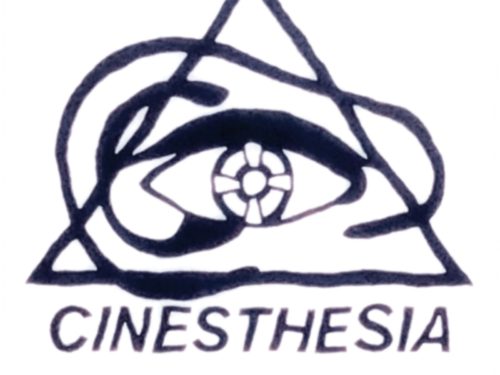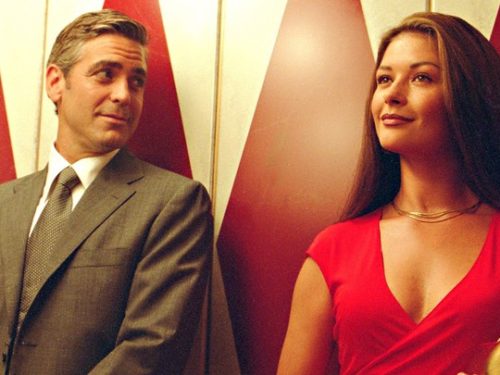Without resorting to empty shock value or pure didacticism, Blood of the Beasts still manages to both startle and implicate the audience with its tour of post-WWII Paris abattoirs
Editor’s Note: This is a film about slaughterhouses. This post contains disturbing images and descriptions.
Documentaries that take cameras inside slaughterhouses are typically little more than cinematic hairshirts. With the help of deadening montage and didactic direct address, they rub our noses in animal-exploiting Industry filth. As its title implies, Georges Franju’s Blood of the Beasts has plenty of blood and guts. There’s no shortage of bile in its 22 minutes either, but it’s a sly and even humorous take on grim material as much as an angry, despairing one. Franju flirts with some of cinema’s hackiest tricks and nevertheless creates a short cinema classic from material that today might’ve been stretched into a feature-length infographic. By its very nature, the film risks dealing in shock for shock’s sake and, even worse, “ain’t I a stinker” irony, the kind displayed when a filmmaker juxtaposes the horrific and banal. Franju most definitely embraces irony. It’s so relentless and so bleak, however, that we know he’s grimacing more than smirking. If his irony has a distancing effect, it’s the kind of distance that helps one see something from a clearer vantage. In addition to traditional scene transitions like dissolves, Franju occasionally employs lightly surreal, storybook effects to help transport the viewer from place to place. One such sequence involves a paper fan opening to cover the screen, another includes a clasp like the one that might hold a diary closed. They all suggest the impossibly naive perspective, a point-of-view both cinematic and childlike, necessary to forget the violence undergirding everyday institutions or to feel especially moved by most conventional depictions of it.
As early as the opening credits, Franju begins to undercut the sense of seriousness and social import that typically accompany films from Blood of the Beasts’ enduring subgenre. His approach is like that of the butchers he’ll soon depict, both merciless and methodical. A grand, dramatic score, befitting the biblical title and mighty bull statue on screen, suddenly gives way to faux-Francophone muzak. It fits what’s ultimately a kind of travelogue film. Franju and his pair of narrators show us the sections of Paris that might’ve stayed hidden if not for all the roads and train tracks running through them. He finds the perfect metaphor for the mix of pride and shame that accompanies industrial meatpacking in a bust of Emile Decroix, “Proponent of Horse Meat.” Stored away in an alcove outside the Vaugiraud slaughterhouse, it shows that the people of Porte de Vanves feel conflicted about their horse meat-rich history. Even still, slaughter is so essential and so normalized that even shame can only be evidenced in slightly muted commemoration.
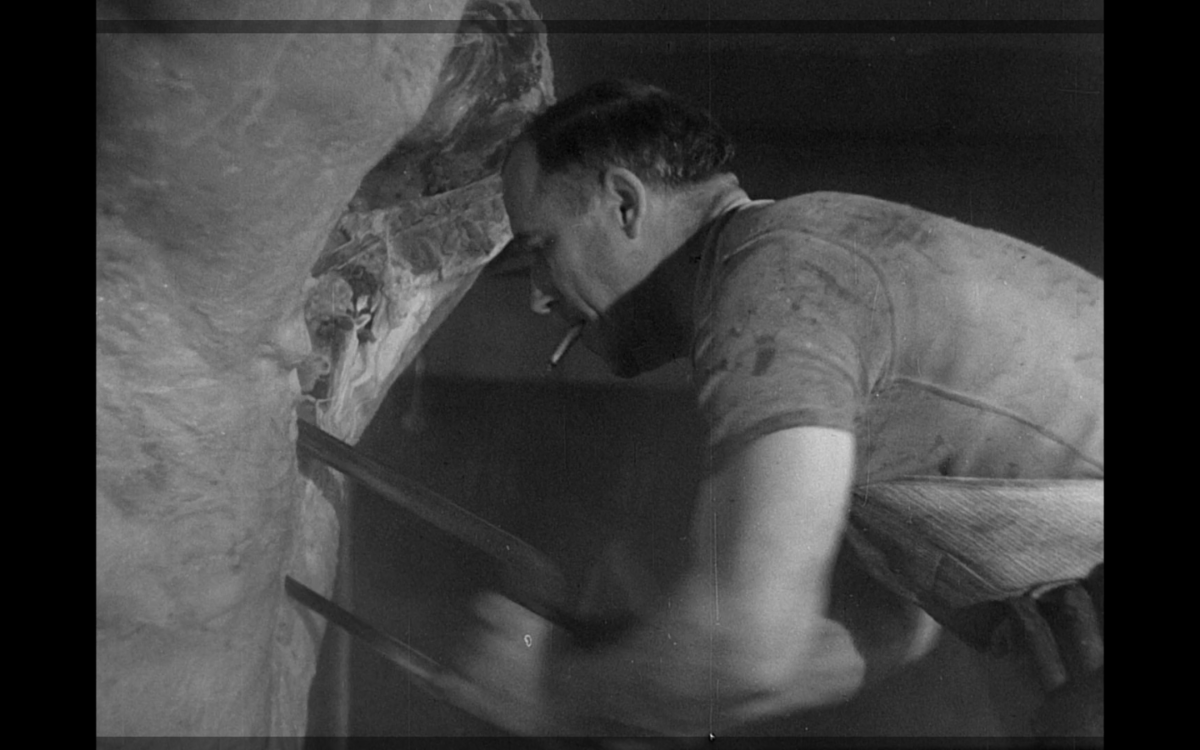
Streets, canals, and railways form the veins and arteries pumping “the blood of the beasts” throughout France and are less easily hidden than portraits and statues. They can’t really be hidden at all. Even the alien setting of the film’s opening moments is described as “Amid the trucks and trains.” The vehicles prove ubiquitous both here and on the other side of the city’s gates. More importantly, they bridge the gap not just between Paris and its outer reaches, but between the walls of happy homes, the doors of respectable shops, and the gates of abattoirs. “The slaughterhouse,” a narrator later informs us, “is linked to the marketplace by a bridge.” Trains pass through the background of shots, circling like predators or even vultures looking for “unique relics of riches past.” A shot of trucks barreling down the road transitions us into the urban center of Paris and toward the first of several slaughterhouses. They seem to have taken over for the trains and shepherded us onto a new leg of our journey. That said, it would do Franju a disservice to characterize either type of vehicle as taking us deeper into Hell. He takes pains to show us that the film’s bucolic (if eerie) and horrific (if socially accepted) settings exist on the same plane. Even once we’re inside the slaughterhouse, a truck is standing by just outside the gate. As we watch the film’s first victim, a striking white horse, slowly clop to its doom, the idling truck sounds a sinister chortle. It reminds us that this horse is an outmoded piece of technology as much as a doomed livestock animal. Horse-drawn carriages once undoubtedly served the same function and stood in the same place as this truck. Technology’s unceasing evolution has brought us to this point just as surely as hunger and acceptance of bloodshed. The sequence is, by Franju’s own definition,1 the most truthful in the film for the way it displaces and recontextualizes both the horse and car, creating an image at once surreal and hyperreal, beautiful and repulsive.
As soon as we’ve set foot inside the gates of the first abattoir, a matter-of-fact introduction to various tools makes plain that Franju’s aim is undoubtedly pedagogical despite his resistance to easy lessons. What we learn during this sequence and throughout the early going helps us make sense of increasingly chaotic compositions later on. It doesn’t offer much comfort to know that the captive-bolt pistol kills animals “instantly” or to see it disassembled — especially not when Franju next breaks the 180-degree rule with an insert shot of the bolt against the horse’s head before snapping back across the line with the bolt’s fatal impact. The horse falls suddenly, like a punch-drunk prizefighter to the canvas. It throws the action on screen into relief and communicates much the same stomach-dropping feeling as a dolly zoom. It’s such a disquieting sight that we only fitfully register the Boschian assortment of horrors in the near and distant background. Steadily and without sentimentality, Franju shows the gradual process by which one kind of product becomes another: horse flesh to horse meat. Other related processes go unseen. We’re left to wonder at the nauseating work necessary to turn hooves into fertilizer and bones into “ladies’ toiletries” and bone black. The very nature of bone black presents an intriguing, gruesome mystery. The casual mention of these processes and by-products — the assumption that we know what bone black is at all — suggests the suffusion of blood into daily life.
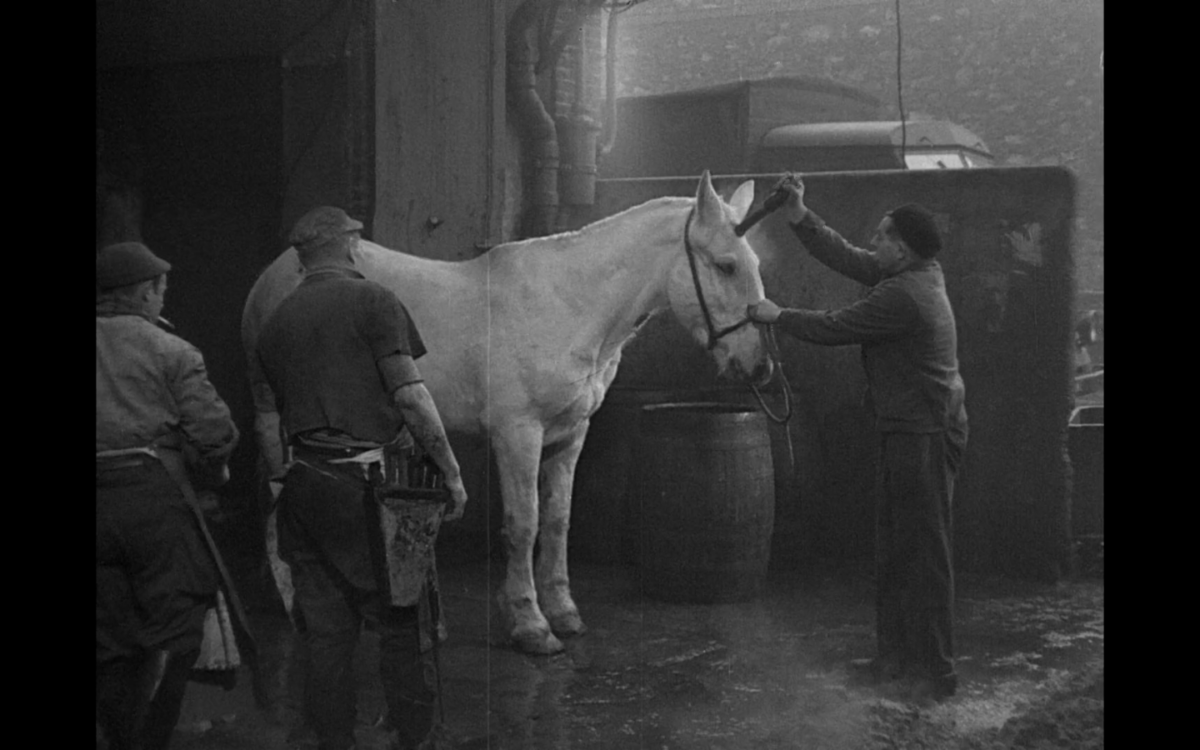
Lest we become desensitized to the action on screen, Franju structures Blood of the Beasts to subtly intensify the brutality and implications of its images. Much as the death of the first horse and resultant butchery shocks unsuspecting viewers, the sequence is tame and the animal’s treatment gentle in comparison to what’s coming. We meet both the “father of meatpacking,” Auguste Macquart, and a modern-day practitioner, Ernest Bruyet. Macquart, long dead and seen via portrait, looks like he’s being fattened for slaughter; Bruyet wears a prosthetic leg as a result of a workplace injury. In the popular imagination, most horses are only killed following injuries or when they’ve reached infirmity in old age. The killing shot is perceived as a way of ending their suffering. There’s a sense that both the animals and slaughterers at Vaugirard wound up where they are for lack of anywhere else to go. That Bruyet’s prosthetic resembles a hoof only further emphasizes the sense that man and beast are closer to equals here, mutually respectful combatants. There is evident dignity in both the horse’s quiet acceptance of death and the slaughterer’s commitment to professionalism in the face of it. The bloodshed and carcasses retain their shock. Still, there’s a delicacy to the flaying and preparations that belies horse meat’s contemporary association with dog food.
As Franju moves from beef, to veal calves, to sheep, the killing and cleaning steadily grows more shocking. There is comparatively little focus on workmanship at the subsequent slaughterhouses and the tools look primitive in comparison to captive-bolt pistols and the steam-powered blades that help delicately flay horse carcasses. Equine butchery, we’re shown, is something worth commemorating in portraits and statues. It’s befitting the close companionship we expect from horses compared to their barnyard peers and the pseudo-humanity that cinema and literature have led us to grant them. At Porte de Pantin, the first condemned cow faces down Maurice Griselle, who was a champion boxer in another life. It’s even more of a mismatch than a typical bullfight, with another human soon entering the ring. “André Brunier, one of the best pole-axers in the Villette,” is shown from the same low angles as Griselle. These imposing shots and inserts of both the steer’s eyes and shit-stained haunches introduce a sense of dread and fear that was missing from the earlier killing. Both the death blow and post-mortem treatment seem excessive in comparison to the careful equine butchery we’ve seen.
Related: The Beauty And Horror Of Eyes Without A Face Is More Than Skin-Deep
Whereas horses are drained of blood with the help of little more than gravity, steers have the blood literally pressed from their bodies. The task is performed with the most primitive of tools — boots. Rather than deploying a specialized instrument like the reed used to sever the spinal cord, slaughterhouse workers simply step on steer carcasses. Rocking back and forth suggests the involuntary movements of the newly killed beast while speeding the bloodletting process. Franju does not find any undue malice in the gesture, yet it can’t help but look callous. The on-screen action is all the more harrowing for the inferences we can make. Far more people eat beef than eat horse; everything we’re seeing is likely that much more common. Before the steer is hoisted for disembowelment and the last bit of bloodletting, a hatchet comes down to shatter another animal’s head with a series of blows. Steam-supported carving comes only after a great deal of hackwork. Franju’s juxtapositions make his arguments overt as the evisceration process begins in earnest. While a worker splits a bloated stomach, one of Franju’s narrators tells us that nuns routinely collect the “fatty scraps” left over when an animal is disemboweled. He not only likens these nuns to scavengers picking over carrion, but draws an overt connection between the Church and this stomach’s steaming, fetid contents. Shots of disembowelment and the aftermath startle despite their lack of commentary. All the hacking and chopping looks barbaric in comparison to the close shaves that helped process horse meat. A quick look at a discarded fetal calf suggests the Church’s hypocrisy while jolting even the jaded viewer yet again.
Blood of the Beasts’ centerpiece sequence focuses on Henri Fournel, who “can split an ox while the clock strikes noon.” Fournel mostly works with a hack-saw, puffing a cigarette all the while and barely breaking a sweat. When Franju cuts to humdrum Paris life, viewed from an objective aerial remove, we can’t help but strain to determine whether or not we’re still hearing the whine of the saw alongside the tolling bell. I don’t think we hear it, though I can’t say for sure. The last few bongs of the bell sound out while Fournel uses the familiar shovel-like hatchet to complete the job. His strikes overwhelm the sound of the bell as the ox’s carcass finally splits in two. For these few seconds, Franju forbids us from turning our focus elsewhere. He subverts his own glibness with this harsh, percussive conclusion to the film’s second slaughterhouse sequence. We have very little time to catch our breath. Fournel walks outside and, rather than follow him, the camera heads in the opposite direction, through an adjacent door back into the slaughterhouse. It soon tracks a calf who’s dragged across the frame by the ear and hind legs.
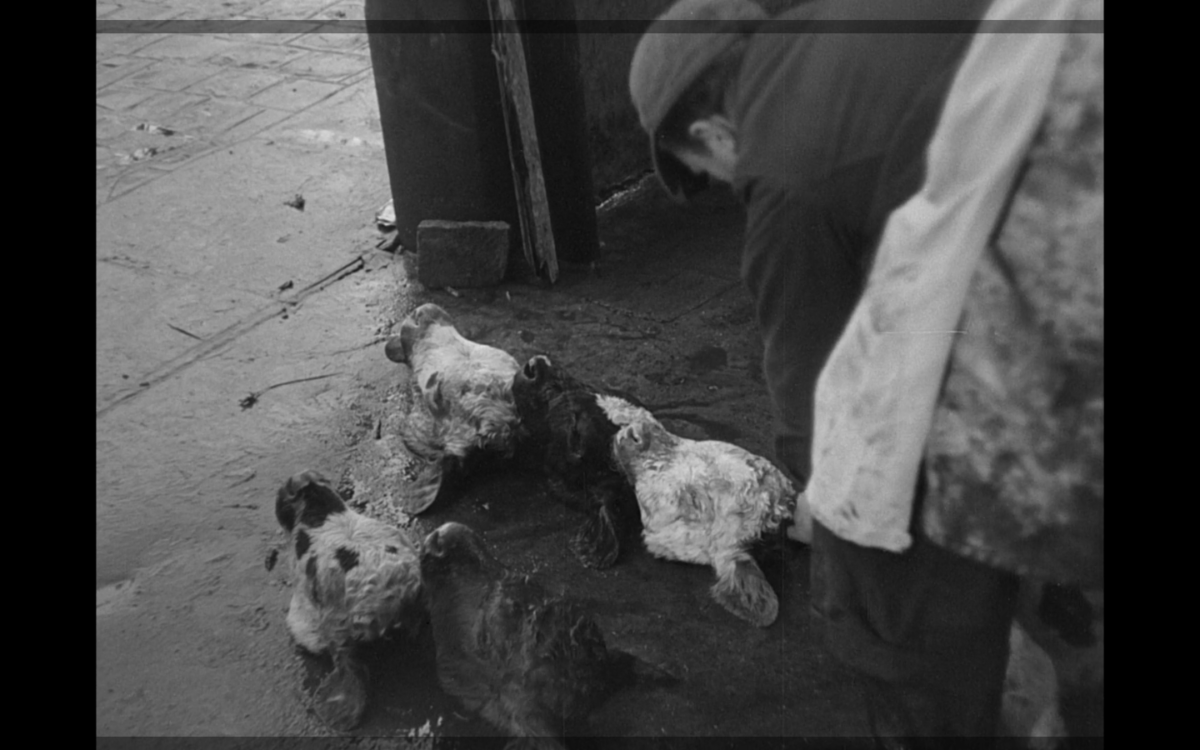
Predictably, the slaughter of veal calves provides for the most brutal sequence yet. Roughly hoisted onto low tables, calves are hogtied and bled by beheading. The process ensures the meat stays white and Franju shows some mercy in depicting just one beheading up close. He can’t resist, however, showing us the frightened eyes of the next calf in line. As harrowing a close-up as any in cinema, it’s the moment Franju most directly mirrors the response of a startled audience. The camera’s subsequent focus on a pile of heads and the limbless, twitching bodies of calves is jarring even as the film is drawing to a close. Labeling the severed heads is the only new process Franju introduces at this stage. Everything else we see is a familiar fright and Franju neglects to linger like he has before. He nevertheless compensates for our acclimatization by amplifying the sounds of butchery. Hacking and slicing overwhelm the soundtrack before they’re replaced by the familiar muzak of the film’s opening sequences.
The process by which lambs are processed looks basically the same as the one for calves. It’s all the more disturbing for how calmly it begins. Dragging one veal calf to the killing table is a two-man job; dozens of sheep follow just one man, thanks to the help of the “traitor” sheep. A relationship where man and beast promote killing as partners cannot help but look like the logical conclusion to all the slaughter we’ve seen. Sheep are killed in the greatest number yet, their undead legs twitching in a perverse dance routine. Workers skin the slaughtered sheep by “punching” them, a gesture that looks like it sounds. One slaughterer punches his way through a sheepskin as Franju’s male narrator quotes Baudelaire, “I shall strike you without anger and without hate, like a butcher.” More grimly ironic juxtapositions follow as someone sings “La Mer:” A frothing gutter full of blood stands in for “silvery glints of the sea;” A woman yanking the guts from a carcass embodies all the “shepherdesses of infinite blue;” paralyzing reeds call to mind “the tall, damp reeds” swaying pond-side; “white birds” are replaced by the bird-like hats of nuns; the “clouds like fleecy sheep” become sheep awaiting slaughter.
Franju knew that shock value alone would never suffice. Maybe he remembered the cautionary tale of Upton Sinclair’s The Jungle (1906). The famous muckraker hoped to move America’s heart, but only managed to turn its stomach with his novel of immigrant suffering and industrial corruption. The Jungle, rather than drawing attention to appalling labor conditions in Chicago and elsewhere, inspired public health legislation and remains infamous thanks to its evocation of sordid, unsanitary meat packing plants and stockyards. The most obvious sign of Franju’s disinterest in pure disgust is the choice of black-and-white photography. “If it were in color,” he’s quoted as saying, “it would be repulsive … the sensation people get would be a physical one.” At the same time, the choice of a late-Fall production schedule provided the right conditions for infernal clouds of steam whenever hot blood hit cold stone. Blood of the Beast’s infernal mise en scene often calls to mind the primitive rites shown in Benjamin Christensen’s Häxan. Franju is perpetually aware of his film’s aesthetic appeal, but he never settles for the stuff of geek shows or polemics.
Comparatively jejune films simply gawk at what goes on inside slaughterhouses and factory farms. Wrongheaded ones focus their ire on low-level employees and settle their goals squarely in the world of consumer responsibility. Dominion (2018), one of the highest-rated documentaries on Letterboxd, is arguably both kinds of film in spite (or perhaps because) of its grotesque clandestine imagery. The film closes with narration from Rooney Mara and Joaquin Phoenix that features significantly more words than Jean Painleve’s entire script for Blood of the Beasts. After offering admittedly staggering statistics about animal suffering and dealing in outrageously crass comparisons, Phoenix makes one last appeal:
“Are we doomed to repeat history over and over? Does this superiority complex, this pure selfishness, define who we are as a species, or are we capable of something more?”
Rather than directly asking empty rhetorical questions, Franju offers a film-length answer suited to the full complexity of the issue and the intelligence of his audience. Better still, he concludes by implicitly raising and answering a question of his own: Are we next? Speeding toward the camera, “the Paris-Villette train” heads for the countryside “to gather tomorrow’s victims.” That last word doesn’t sound like anthropomorphization. Georges Franju is too savvy and has avoided sentiment too deftly to employ a tactic like that now. Instead, he reminds us that the roads are paved, the tracks are laid, and we’re all living amid the trucks and trains.
Purchase Blood Of The Beasts (as an included bonus feature) here
Stay up to date with all things Split Tooth Media and follow Bennett on Letterboxd
(Split Tooth may earn a commission from purchases made through affiliate links on our site.)
Find the complete October Horror 2022 series here:
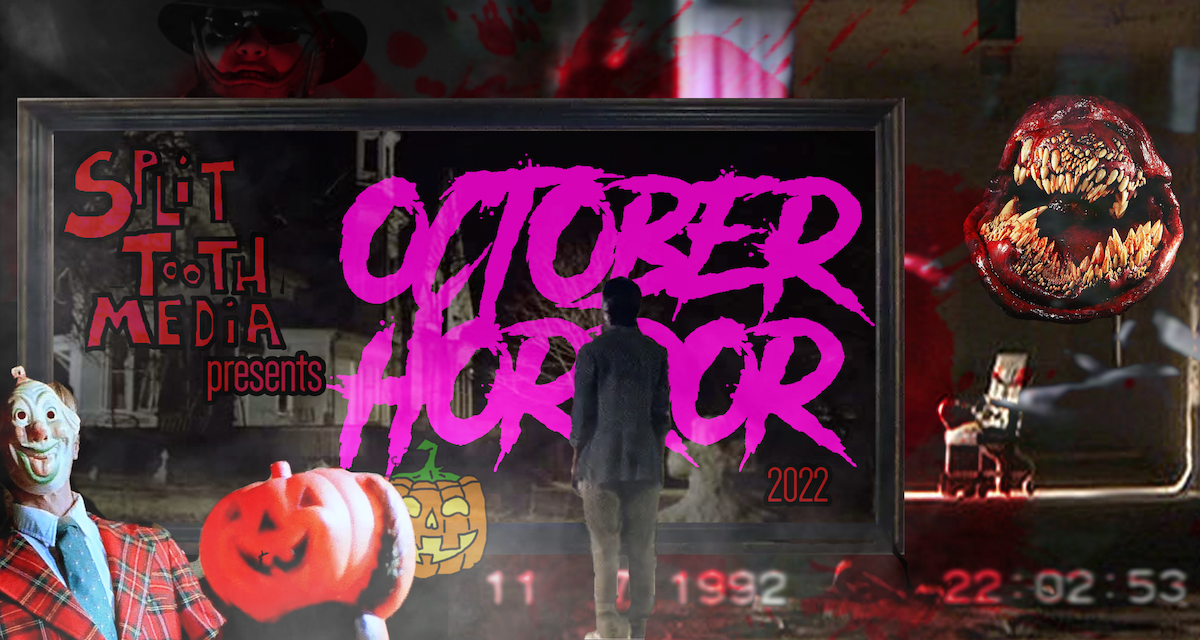
- “I don’t see any way to express that which is intrinsically beautiful — and all things are beautiful — other than by truth. But the way to express it if you’re a realist — if you’re a documentary filmmaker, as I was, is by stripping the object of its frills. To express it as a surrealist, but remaining a realist, is by displacing the object, placing the object in another context. By transforming it, the object rediscovers its quality as an object.” — Georges Franju

